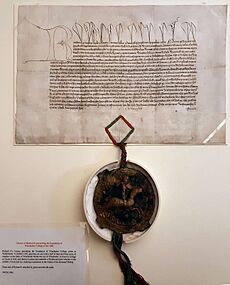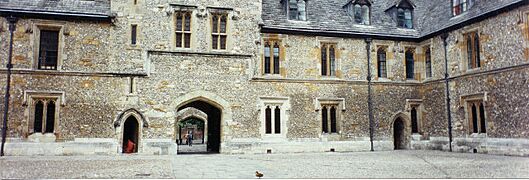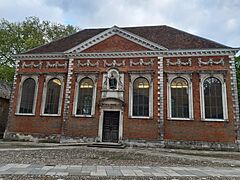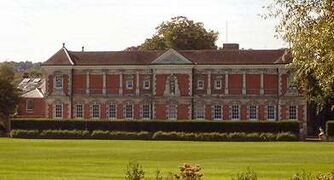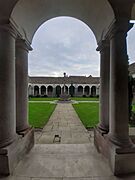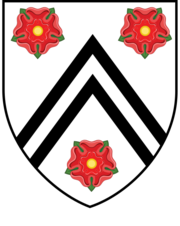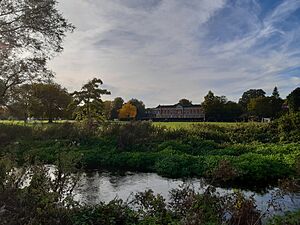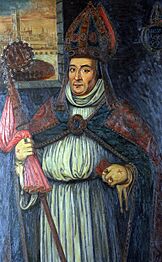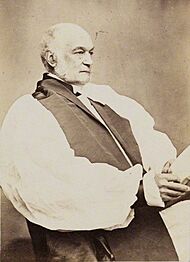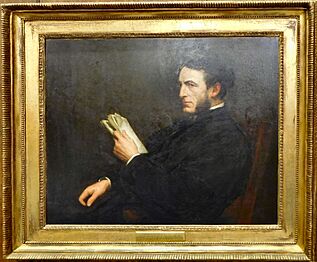Winchester College facts for kids
Quick facts for kids Winchester College |
|
|---|---|
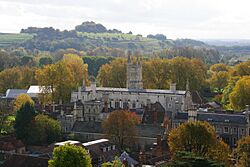
The school seen from Winchester Cathedral
|
|
| Address | |
|
College Street
, SO23 9NA
England
|
|
| Coordinates | 51°03′29″N 01°18′46″W / 51.05806°N 1.31278°W |
| Information | |
| Type | |
| Motto | Manners makyth man |
| Religious affiliation(s) | Church of England |
| Established | 1382 |
| Founder | William of Wykeham |
| Department for Education URN | 116532 Tables |
| Warden | Richard Stagg |
| Headmaster | Elizabeth Stone |
| Staff | c. 350 |
| Gender | Male (mixed at 16-18) |
| Age | 13 to 18 |
| Enrolment | c. 740 |
| Houses | 11 (10 Commoner or Old Tutor Houses plus College):
|
| Colour(s) | Blue, brown & red |
| Publication | The Wykehamist, Quelle, The Spirit Lamp, The Trusty Servant |
| Alumni | Old Wykehamists |
| School song | Domum |
Winchester College is a very old and famous school in Winchester, Hampshire, England. It is a public school, which in the UK means it's a private school where students pay fees to attend. Most students live at the school, which is called a boarding school.
The school was started in 1382 by William of Wykeham. He was a powerful bishop and wanted to create a school that would prepare students for New College, Oxford, which he also founded. Winchester College has been in the same spot ever since it began. It is one of the oldest schools in England.
For over 600 years, Winchester College was only for boys. However, it has started to welcome girls too! Since September 2022, girls have been able to attend as day students in the older years (Sixth Form). Girls started boarding at the school in 2024.
The school was first built to teach 70 scholars. Over time, more students joined, including 16 choirboys and other paying students called "commoners." In the 1860s, ten more boarding houses were added, allowing many more students to join. The scholars still live in the school's original medieval buildings. These old buildings include courtyards, a chapel, and cloisters. A classroom building called "School" was added in the 1600s. Later, an art school, science school, and music school were built. A special memorial called the War Cloister was built in 1924.
Winchester College has many unique traditions. These include its mascot, the Trusty Servant, a special language called "notions", and a school song called Domum. Famous headmasters have included bishops like William Waynflete and George Ridding. Students who used to go to Winchester College are known as Old Wykehamists.
Contents
School History
How Winchester College Started
Winchester College was founded in 1382 by William of Wykeham. He was a very important person, serving as the Bishop of Winchester and a top advisor to two kings, Edward III and Richard II. He started the school partly because there weren't enough trained priests after a terrible sickness called the Black Death. Winchester College was meant to prepare students for New College, Oxford, which Wykeham also founded.
The school's official Latin name means "St Mary's College, near Winchester." The first 70 "poor scholars" started at the school in 1394. Back then, "poor scholars" meant students from families with very low incomes.
Winchester College was special because it used older students, called prefects, to help with discipline. The rules were also meant to be less harsh than in many other schools at the time. It was also unusual because it taught boys aged 12–18, which was the age range for universities back then. These ideas, including having a school linked to a university, became a model for Eton College and King's College, Cambridge about 50 years later. Eton and Winchester became close partners.
At first, only a few students who weren't scholars were allowed. By the 1400s, the school had about 100 students in total. This included the 70 scholars, 16 choirboys (called "quiristers"), and the rest were "commoners" (paying students). Many people wanted their children to be commoners, and their numbers slowly grew.
Changes Over Time
Because Winchester College was also a religious place, it was almost closed during King Henry VIII's time. But he died before it happened. King Edward VI then made changes, allowing worship and Bible readings to be in English instead of Latin. Later, Queen Elizabeth I allowed Winchester and Eton to keep using Latin for religious services. This helped students practice their Latin skills.
From the 1860s, ten new boarding houses were added. Each house could hold up to sixty students, which greatly increased the school's size. By 2020, there were 690 students.
As of 2022, Winchester College started accepting girls into the Sixth Form (Year 12) as day students. Girls began boarding at the school in 2024. In 2025, the college announced it would fully merge with The Pilgrims' School in September 2025.
School Buildings
Winchester College has many different buildings, some very old and some more modern. There are 94 buildings that are officially protected because of their history. The school grounds cover about 250 acres. This includes water meadows, playing fields, and formal gardens. St Catherine's Hill is also part of the area.
The oldest buildings are from when the school first opened in 1394. These include the Outer Gate, Outer Court, Chamber Court, the chapel, and the Cloisters. They are built with flint stone, limestone, and slate roofs. The chapel still has its original wooden ceiling. Some of the old stained glass from the 1820s is now in special areas called Thurburn's Chantry and Fromond's Chantry.
The "School" building was built between 1683 and 1687 in a style similar to the famous architect Christopher Wren. It has a statue of the school's founder above the door. In the 1800s, many new boarding houses were added for the "commoners" (paying students). The scholars continued to live in the older, medieval College buildings.
Around the year 1900, a Music School, an "Museum" (which is an art school), and a Science School were built. A large new hall, called New Hall, opened in 1961. It holds the old oak wood panels that were taken from the Chapel in 1874. In 1924, a War Cloister was built. It is a memorial to students who died in the two World Wars.
Visitors can tour parts of the school like Chamber Court, the chapel, College Hall, the Cloisters, School, and Museum for a fee.
-
School in Wren style, 1683–1687
-
Sergeant's House by G. E. Street, 1869
-
War Cloister by Herbert Baker, 1924
Student Life
Where Students Live
The seventy scholars live in the oldest buildings, known as "College." These scholars are called "Collegemen." The teacher in charge of them is called the Master in College. Collegemen wear black gowns, which is a tradition from when the school started. They have some special benefits, like having open fires and being allowed to walk across Meads, which is a walled sports field outside the School building.
Boarding Houses
Every student at Winchester, except for the scholars, lives in a boarding house. Students choose or are given a house when they apply to Winchester. This is where they study, eat, and sleep. Each house has a housemaster, who is also a teacher, and house tutors who help out. The houses compete against each other in school sports.
Each house has an official name, usually from the first housemaster's family name. They also have an informal name, often from an early housemaster's nickname. Each house also has a letter, given in the order they were founded. For example, a student from Furley's house is called "a Furleyite."
Learning at Winchester
How to Get In
Winchester College is known as one of the best schools in the world. It has its own special entrance exam. Students who want to join a Commoner House usually arrange to take a test and interview with the housemaster about two years before the main exam.
Students applying to College take a separate, harder exam called "Election." If they do well, they might get a scholarship or a special nomination from the Headmaster to join a Commoner House. Scholarships used to mean free tuition, but now the school offers financial help (called means-tested bursaries) based on how much a family needs it. These bursaries can cover from 5% to 100% of the school fees.
As of 2022, Winchester started accepting girls into the 6th form (Year 12) as day students. Girls began boarding at the school in 2024. For the 2023/24 school year, the fee for boarding students was £49,152 per year, and for day students, it was £36,369 per year.
What Students Study
Besides regular lessons, all students must attend a class called Division (or "Div"). This class explores history, literature, and politics that are not part of exams. Its goal is to give students a wide-ranging education.
From Year 9, students study for at least nine GCSE and IGCSE exams. Every student studies English, mathematics, Latin, French or German, and at least two sciences. They also take "Div." After that, students study three A-levels, "Div," and an Extended Project Qualification.
Exam Results
Winchester College is known for its strong academics.
In 2023, for A-Level exams, nearly 80% of student results were graded A*-A, with over 42% being A*. For GCSE exams, almost 90% of results were graded 7 or higher, and over 73% were grades 8 or 9. More than half of all grades were the top grade, 9. In the same year, 17% of students went on to study at Oxford or Cambridge universities. Many also went to top US universities like Harvard and Columbia.
Between 2010 and 2018, about 33% of students who left Winchester College went to Oxford or Cambridge.
School Activities
Sports
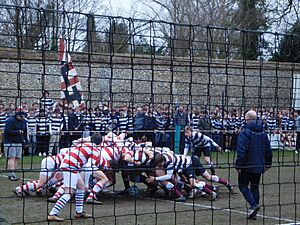
Winchester College has its own unique game called Winchester College football (also known as "Win: Co: Fo:" or "Winkies"). It is only played at Winchester. This game is played in the spring term, with houses competing against each other. The students largely manage the game themselves.
The school also has a special version of fives, which is similar to Rugby fives. It has a unique wall feature that makes the ball bounce in unexpected ways.
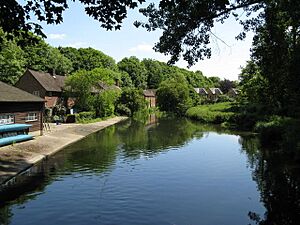
The school has an active rowing club called the Winchester College Boat Club. It is located on the River Itchen. The club has won the Princess Elizabeth Challenge Cup twice (in 1949 and 1954) at the Henley Royal Regatta.
There has been a friendly rivalry, especially in sports, between Winchester and Eton for hundreds of years.
Combined Cadet Force
Students in their second year at Winchester College are currently required to join the school's Combined Cadet Force (CCF).
The CCF started in 1860 as "The Winchester College Rifle Volunteer Corps." It was created by older students because they felt there was a threat from Napoleon III. At first, it was run by the students themselves. In 1908, it became the Officer Training Corps. By 1914, during World War I, almost every student joined to help with the war effort. In World War II, it was called "The Junior Training Corps." In 1948, it became the "Combined Cadet Force" (CCF), and it included sections for the RAF (Royal Air Force) and RN (Royal Navy). Since 1963, students who don't want to join the CCF can choose "Alternative Service Activities" instead. Students can opt out of the CCF at the end of their second year.
Music
Winchester College offers many chances for students to develop their musical skills. Two-thirds of students play at least one instrument. The school has a music school and many practice rooms. There are also various choirs, music groups, and orchestras. The chapel choir has been around since the school was founded. Students who are good at multiple instruments (Grade 6 or higher) can get scholarships that pay for their music lessons.
School Traditions
The Trusty Servant: School Mascot
The Trusty Servant is a special painting at Winchester College. It is the school's unofficial mascot and also the name of its magazine for former students. The painting and a poem about it were created by the poet John Hoskins in 1579. They hang outside the college kitchen. The current painting was made in 1809.
The painting shows a mythical creature. It has the body of a man, a pig's head with a padlock on its snout, the ears of a donkey, and the feet of a deer. It holds tools in its left hand. The poem describes the good qualities that students at the college are supposed to have. The school's coat of arms is in the background of the painting.
Notions: The School Language
A notion is a special word or phrase used only at Winchester College. The word "notion" also describes unique traditions at the school. For example, "toytime" means homework. This comes from the word "toys," which are wooden cubicles where students work in a shared room. These rooms are called "mugging hall" in Commoner Houses or a "chamber" in College.
Manners Makyth Man: The School Motto
Since it was founded, Winchester College has had many special words and phrases linked to it. This includes its motto, its graces (short prayers), and a longer prayer. A grace is read before and after every lunch and formal meal in College Hall. Two different graces are traditionally sung during "Election," which is the scholarship process.
Manners makyth man
– This is the motto of Winchester College, New College, Oxford, and their founder, William of Wykeham.
Here is the Latin grace said before meals in College, with its English meaning:
| Latin grace | English translation |
|---|---|
|
Benedic nobis, Domine Deus, |
Bless us, Lord God, |
And here is the Latin grace said after meals in College, with its English meaning:
| Latin grace | English translation |
|---|---|
|
Agimus tibi gratias, |
We return thanks to Thee, |
Domum: The School Song
The school song is called "Domum." It is sung at the end of the summer term. No one knows exactly when the song started, but it was called "an old tradition" in a book from 1773. The traditional music for the song was written by John Reading. A new tune was officially adopted by the school around 2007.
According to a legend, the words to the song were written in the 1600s by a student who was kept at school for misbehaving during the holidays. Some say he carved the words into a tree, which was then called "Domum Tree." He then supposedly jumped into the river that runs through the school grounds. There is still a "Domum Cottage" in that area today.
A "Domum Dinner" is held at the end of the summer term for students who are leaving the school.
Winchester College's Impact
Winchester College's way of teaching influenced many schools that came after it. It was unusual in medieval times for teaching boys aged 12–18, as universities accepted students in this age range. The age range, the link with New College, Oxford, and its approach to discipline became a model for Eton College and King's College, Cambridge about 50 years later.
Students from Winchester College have appeared in many stories and books. The school itself appears less often. A well-known former student in fiction is Sir Humphrey Appleby from the TV show Yes Minister.
Like other famous public schools, a train from the Southern Railway was named after Winchester College. This train, No. 901 Winchester, started service in 1930.
Headmasters of Winchester College
Here are the headmasters of Winchester College from the 14th century until now:
- 1373 Richard Herton
- 1388 John Melton
- 1394 Thomas Romsey
- 1407 John Pole
- 1414 Thomas Romsey
- 1418 Richard Darcy
- 1424 Thomas Alwyn
- 1430 William Waynflete
- 1441 Thomas Alwyn
- 1444 William Yve
- 1454 John Barnard
- 1459 John Grene
- 1465 Clement Smyth
- 1467 Richard Dene
- 1484 John Rede
- 1490 Robert Festham
- 1495 William Horman
- 1501 John Farlyngton
- 1507 Edward More
- 1515 Thomas Erlisman
- 1525 John Twychener
- 1531 Richard Twychener
- 1535 John White
- 1542 Thomas Bayly
- 1547 William Everard
- 1553 Thomas Hyde
- 1561 Christopher Johnson
- 1572 Thomas Bilson
- 1579 Hugh Lloyd
- 1588 John Harmar
- 1596 Benjamin Heydon
- 1602 Nicholas Love
- 1613 Hugh Robinson
- 1627 Edward Stanley
- 1642 John Pottinger
- 1653 William Burt
- 1658 Henry Beeston
- 1679 William Harris
- 1700 Thomas Cheyney
- 1724 John Burton
- 1766 Joseph Warton
- 1793 William Stanley Goddard
- 1810 Henry Dison Gabell
- 1824 David Williams
- 1836 George Moberly
- 1867 George Ridding
- 1884 William Andrewes Fearon
- 1901 Hubert Murray Burge
- 1911 Montague John Rendall
- 1924 Alwyn Terrell Petre Williams
- 1934 Spencer Leeson
- 1946 Walter Fraser Oakeshott
- 1954 Henry Desmond Pritchard Lee
- 1968 John Leonard Thorn
- 1985 James Paley Sabben-Clare
- 2000 Nicholas Tate
- 2003 Thomas Richard Cookson
- 2005 Ralph Douglas Townsend
- 2016 Timothy Roderick Hands
- 2023 Elizabeth Stone
-
William Waynflete as bishop, c. 1470
Famous Former Students
Students who currently attend Winchester College are called Wykehamists, named after the school's founder, William of Wykeham. Students who have left the school are known as Old Wykehamists, or sometimes "Old Woks" among themselves.
Fictional Old Wykehamists have appeared in over 50 novels, starting with Peregrine Pickle in 1751.
See also
 In Spanish: Winchester College para niños
In Spanish: Winchester College para niños
- List of the oldest schools in the United Kingdom


